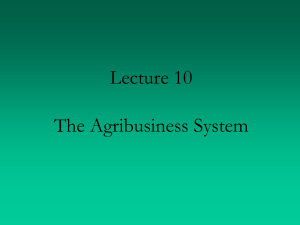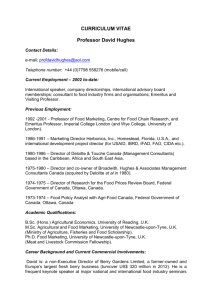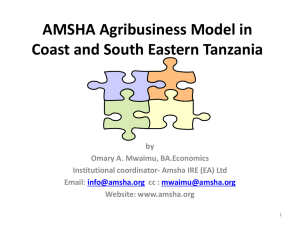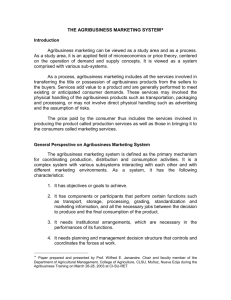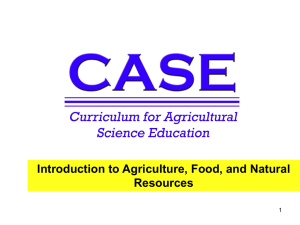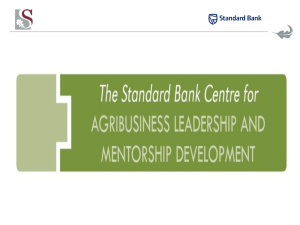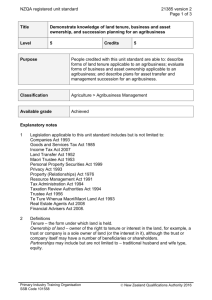Lecture __. The Agribusiness System
advertisement
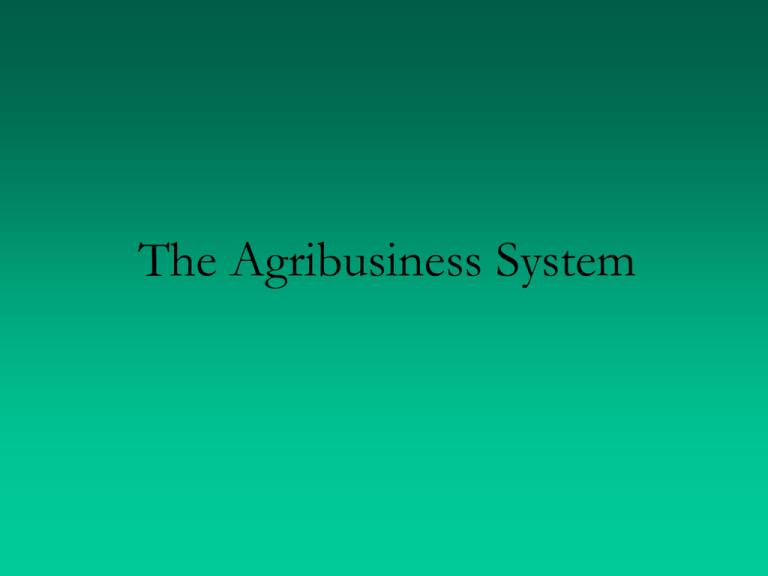
The Agribusiness System Objectives • The “agribusiness system” approach to marketing • Size and scope of agribusiness • Various sectors • Marketing in the economy • Functions of marketing • Marketing in agribusiness firms History • What is agriculture to most people? Farming, ranching, fishing?? • This was true until the early 1960s when “agribusiness” evolved into a complex system reaching well beyond the farm • The big picture included all things needed to bring food to the consumer. • As it turned out aquaculture shares many similarities to traditional agribusiness. Agribusiness History • The agribusiness system includes many facets: • Not only production (e.g., farmers, hatchery managers), also • Organizations which provide inputs (e.g., fry, chemicals, feed) – Processors the output (e.g., processing plants) – Manufacturers (e.g., shrimp microwavable products) – Transporters/Sellers/Brokers (e.g., retail grocery stores, seafood wholesalers, etc.) Agribusiness: Evolution • Late 1800’s: self-sufficient farms! • Then wars increased produce prices, stimulating more production (Recall: demand and supply). War was profitable even back then! • Mechanization was developed largely due to labor shortages. • Crop production became a focus of farmers. (They started purchasing inputs; this is where aquaculture is today!) • Much of the manufacturing and processing was relocated off the farm to become businesses themselves. • Preservation of raw products was also improved. • This made food more convenient to consumers. The Agribusiness System Aquaculture Input Sector Production Sector ProcessingManufactoring Sector Agribusiness System Note: the success of each part depends upon the proper functioning of the other two! Agro-input subsystem: Seeds; Agro-chemicals; Agro-machinery; etc Agricultural Production Subsystem: Crop; Horticulture; Aquaculture; Animal Husbandary; Forestry Agro-Industrial Subsystem: Marketing Subsytem: Food industry; Food processing; Natural fiber industry; and cigarette industry Distribution; Promotion, Information market; Trade and Market structure Service and supporting of Agricultural subsystem: Credit; Insurance; Transportation, Government Policy; Education; Agricultural Extension; Institutional 7 The Input Subsector • Provides farmers with all things needed for production: feed, fry, equipment, fuel, chemicals • Total level of inputs remains stagnant since WWII; but, type of inputs has varied greatly. • If labor costs increase, you typically see a shift towards increased purchase of inputs (Since 1960, farm labor has decreased 50%!) • Purchase of more inputs actually facilitates more production. The Input Subsector • Use/efficiency of energy usage has also changed. • Relatively few input businesses compared to production or processing (look at feed manufacturing vs. the number of farms!) • Why is this trend observed?? The Production Subsector • Larger farms in all areas (including aqua-)! • Corporate farms • New technologies have resulted in increased specialization of production – genetically altered animals – specific pathogen-free stocks (big deal in aqua-) • What does this mean? • Stability in that aquaculture production is becoming more diversified The Production Subsector • Specialization also allows for increased production efficiency (telltale sign: increased production in face of decreased or constant levels of input) • Another blast from the past: production economics – production costs increase every year due to increase input cost – but cost of inputs is not related to commodity prices (e.g., shrimp) – when commodity prices drop, gross farm income falls, but amount spent on inputs doesn’t (the great squeeze!) The Production Subsector • Two sizes of farms: Large (economies of scale) and small (no economy of scale) • Large farms: new technologies (aeration, telemetry, genetically-improved strains) • Small farms can also, however: sell something that commands a high price! ($16/lbs. shrimp!) The Processing-Manufacturing Subsector • Includes all business that turn raw materials into finished (or partially-finished) products • In aquaculture, mostly done by processors • Also includes packaging, distribution, and sales, places and forms desired by consumers (Marketing bill?) • Marketing bill represents 70% of total amount spent by consumers on food!!! The Processing-Manufacturing Subsector • Firms in this sector are very large (again, gathering economies of scale); very responsive to consumer tastes/ preferences • Examples: Indofood; WingsFood; GarudaFood; Cargill, etc Packaging Transportation Before-tax profits Fuel and power Depreciation Advertising Rent Net interest Repairs Other Labor The Marketing Bill: What are you paying for? Big Companies: How do they work? • Obviousley, aquaculture depends flexibility and diversification for sucess, not isolation. • Many large companies have divisions in other parts of the agribusiness system • Example: Cargill, Inc., one of the largest grain traders in the world, also largest soybean processor, flour miller, feed manufacturers, seed producers, etc.!!! Part 2: Role of Marketing in the Agribusiness System • Lowers prices/increase availability 1) bridge between producers and consumers 2) helps producers understand consumer needs 3) helps producers decide what to produce 4) helps consumers know what products are available and at what prices • Bottom Line: Consumer satisfaction!!, higher profits for producers! Everyone wins!! • Extension of the business world?? Maybe! Conflicting Needs of Producers and Consumers P roducers seek to C onsum ers seek to M axim ize long-term profits M axim ize the happ iness they receive from the products they consum e w ith their lim ited incom es B uy sm all quantities of m any products Sell large quantities of a few products Four Utilities of Marketing • form: to process the product into a form desired or needed by the consumer (fish in the round vs. nuggets) • place: transporting the product to a location desired by the consumer (shipping, convenience= big deal!!!) • time: storage • possession: gaining ownership so it can be legally used Evaluating Performance of the Marketing System • How well does the marketing system meet the needs of consumers?: it has to be measured • Two criteria or yardsticks: efficiency: how well goods and services flow from businesses to consumers fairness: how the marketing system meets the needs of the consumers • When you buy something, you are saying that you like the price, the goods/services, etc. • Rating of the system is indirect through voting and has led to the rise of consumerism. Market Performance Evaluation Criteria • Market Structure – number and size of firms in the market (no monopolies) – barriers to market entry/exit (not prevented by other firms) – degree of product and price competition (allows increased quality) • Conduct of Firms in the Market – – – – firms compete via price (sell at lower price) no unlawful cooperation between firms (price fixing-this still happends) truthful product claims (better? Show me the data!) meaningful product differences (Are different models different?) • Market Performance – optimal output available at minimal price (appropriate tech, conserve resources) – reasonable levels of profits (good firms deserve this) – encouragement of innovation (products should be improved over time, how is this possible with seafood??) – reasonable levels of investment (firms support in industry, new tech, higher efficiency, devleopment of company)
